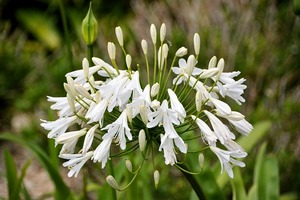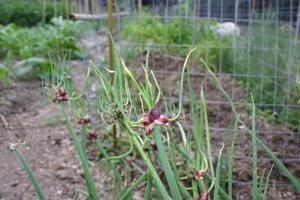A Pungent Crop
March 9, 2022
The culinary onion - Allium cepa - has been in cultivation for at least 7000 years. We have no record of what its wild form was like. There are a few closely related onion species found in the wild today but they are not the onion we find either in the grocery store or the history books.
It was a staple crop in every culture.
This week I want to concentrate on A. cepa but since we're talking about the garden today I want to mention the ornamental alliums. They bloom in that late spring/early summer lull when so little else is blooming and they have such an unusual and distinctive shape that they earn their space in the garden.
Ornamental Alliums are generally hardy in zones 6-8, however, there are a few varieties that are hardy to zone 4. They all have a flowering head which is either the signature round grouping of individual flowers at the top of a long fleshy stem or a looser variation of the theme. They generally come in some shade of purple or white but you can find them in a number of colors if you look around. They work best as an accent grouping in a perennial bed.
Here are a couple of links to get you started – first, a pdf of an article from The American Gardener magazine and this site, which has not only historical information but has an easy to read list of some of the varieties and their requirements.

Now, on to A. cepa – the onion.
![Forest & Kim Starr [CC BY 3.0 (http://creativecommons.org/licenses/by/3.0)], via Wikimedia Commons Forest & Kim Starr [CC BY 3.0 (http://creativecommons.org/licenses/by/3.0)], via Wikimedia Commons](https://echoesofthegarden.net/wp-content/uploads/2017/03/Starr_070313-5656_Allium_cepa-web.jpg)
Rodale Institute gives us three different options for starting onions, and information on how to grow and harvest them.
Those of us in areas with long, cold winters might want to consider starting our onions indoors so they get a head start on the outdoor garden. The Maine Organic Farmers and Gardeners Association tells how here.
There are several advantages to growing them in containers even if you have space in the garden. Onions don't compete well, especially when they're young, and it's easier to keep ahead of weeds in a container. If you plant two pots of bunching onions three weeks apart, you can use them for a "cut and come again" crop by allowing the first to rest and regrow while you use the second. Egyptian Walking onions grow happily in a container. They're a lovely plant and fit right in with the container garden on my porch. Find out more about growing onions in containers here and here is information specifically on growing green onions.
Here's a fun idea - grow another onion from the bottom of the onion you ate for dinner.
In the same vein, you can regrow the green onions you find at the market. I found this video about it fascinating. This could be used as a school project for the kids.
The term “bolt” in gardening means “to flower and then set seed”. Often the flavor and texture of the plant changes when it bolts. Here's an article to help you if your onion bolts.
A. cepa is a biennial. That means it lives for two years and sets seed in the second year. Other than the wait, saving seeds from a biennial is the same process as saving from an annual. This site has a good tutorial.
There are a few other types of onion you can grow, bunching onions (A. fistulosum) and walking onions (A. proliferum).
Bunching onions are the “green onions” you find in the grocery store.
![By Daderot (Daderot) [CC0 or CC0], via Wikimedia Commons By Daderot (Daderot) [CC0 or CC0], via Wikimedia Commons](https://echoesofthegarden.net/wp-content/uploads/2017/03/Allium_fistulosum_-_Copenhagen_Botanical_Garden_-_DSC07943-web.jpg)
This Good Gentle is enthusiastic about growing bunching onions.
I grow walking onions in my garden. I will say that they've turned out to be one of the easiest crops I've grown. I still haven't tasted one because I was originally given one bulblet and I've spent the last two years letting the plants multiply. I believe that I'll have enough this year to actually eat some. Here's the official website for it if you'd like to know how to grow them yourself

This video has clear pictures and shows how to prepare the walking onions for use in the kitchen. Be warned! Watching him make the omelet is enough to make you hungry.
No, I haven't forgotten either chives or garlic. Both of those plants deserve their own weeks' worth of attention, which I will give them another time. Meanwhile, if you have stories of growing or foraging onions, please share them in the comments below and remember to like and share this blog. Thanks for stopping by!



![By Maxlegran (Own work) [CC BY 3.0 (http://creativecommons.org/licenses/by/3.0)], via Wikimedia Commons By Maxlegran (Own work) [CC BY 3.0 (http://creativecommons.org/licenses/by/3.0)], via Wikimedia Commons](https://echoesofthegarden.net/wp-content/uploads/2017/03/Onion_Grass-web.jpg)